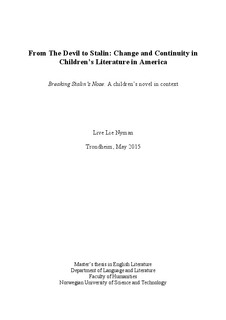From the devil to Stalin : change and continuity in children's literature in America : breaking Stalin's nose : a children's novel in context
Master thesis
Permanent lenke
http://hdl.handle.net/11250/300372Utgivelsesdato
2015Metadata
Vis full innførselSamlinger
Sammendrag
This thesis will establish that books for children in the seventeenth and eighteenth
century were clearly religious and moral. Besides teaching literacy, they taught lessons about the importance of Christianity and obedience to one’s elders and betters. Gradually over the course of the nineteenth century, however, fictional texts for children
became more sophisticated and nuanced. Some books trained young girls in particular how to prepare for a fuller part in society, and how to deal with secular problems as well as advancing religious ideals. In the twentieth century, Christianity could s
till influence children’s books, but the messages were less obvious.
In attempting to tease out the purpose of Yelchin’s book, I will begin with an overview of American children’s literature in Chapter 1, before analyzing Breaking Stalin’s
Nose in Chapter 2. How does ideology manifest itself in more recent
children’s literature, and what does Yelchin do that is similar or different from historical
children’s literature? I would also like to find out what is presented in opposition to
communism, and what the purposes of children’s literature are in the past, and today? How do children’s books deal with such “adult” themes as history and class?
In addition to looking at some of the contexts of Breaking Stalin’s Nose,
I will also look at the generic aspects of the book, to explore how the style and illustrations, however personal and unique, conform to or differ from the formal tradition of children’s literature. Finally, the book’s reception in the US will be analyzed. What did
critics and reviewers say about the book, and can this be related to America’s sense of its own role as the flagship of democracy? The book might be seen as liberal, but
can also be taken as conservative, since to be anti-communist is often a starting point for conservative groups in the United States. Can a book's meaning depend a great deal on when and where it is read?
